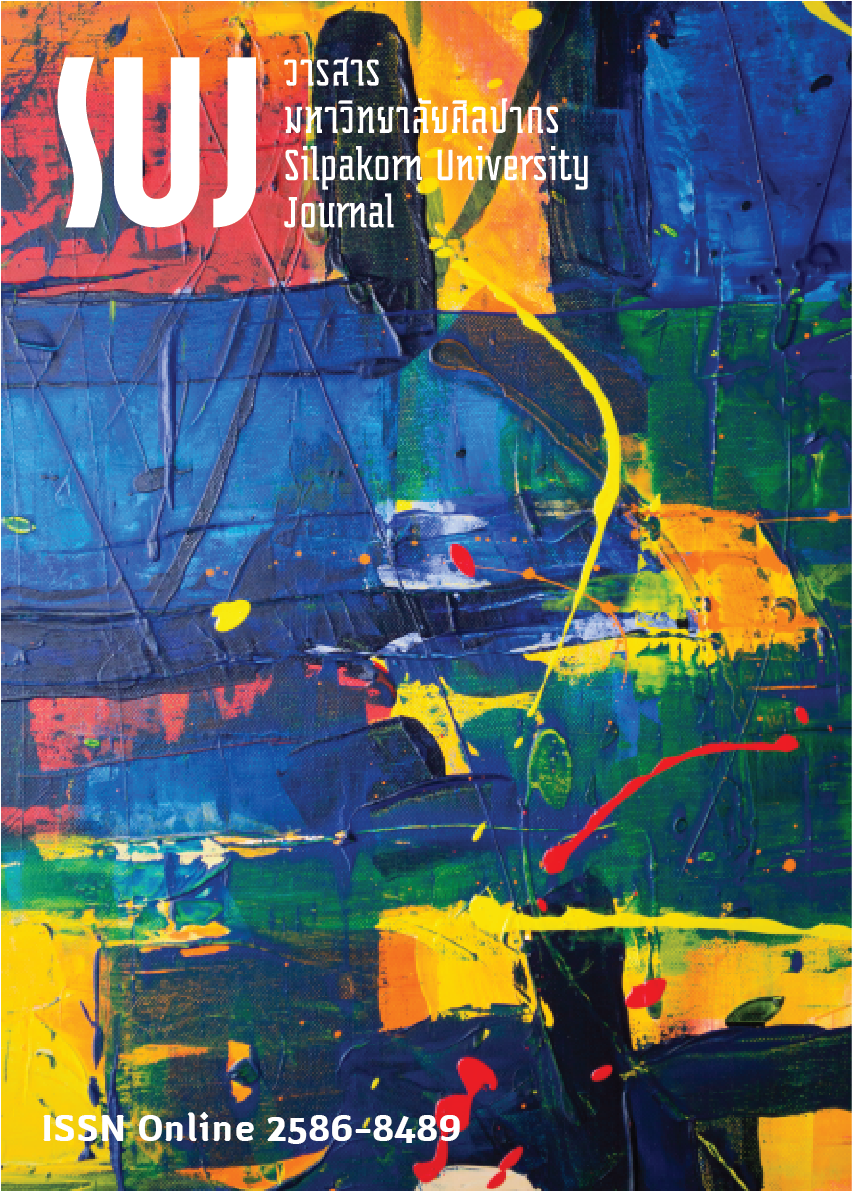การเรียนรู้วิธีการสอนของนักศึกษาครูคณิตศาสตร์ในการพัฒนาการคิดทางเรขาคณิต ของนักเรียนในชั้นเรียนที่ใช้การศึกษาชั้นเรียนและวิธีการแบบเปิด (Mathematics preservice teachers’ learning of how to teach to develop students’ geometric thinking in classroom using lesson study and open approach)
Main Article Content
Abstract
งานวิจัยนี้มีวัตถุประสงค์เพื่อศึกษากระบวนการเรียนรู้วิธีการสอนของนักศึกษาครูคณิตศาสตร์ในการพัฒนาการคิดทางเรขาคณิตของนักเรียนในชั้นเรียนที่ใช้นวัตกรรมการพัฒนาวิชาชีพครูด้วยการศึกษาชั้นเรียนและวิธีการแบบเปิด ชั้นเรียนกรณีศึกษาที่ใช้เป็นหน่วยในการวิเคราะห์ประกอบด้วยครูในทีมการศึกษาชั้นเรียน และนักเรียนชั้นประถมศึกษาปีที่ 4 ในโรงเรียนที่ใช้นวัตกรรมการศึกษาชั้นเรียนและวิธีการแบบเปิด ในจังหวัดเชียงใหม่ ผู้วิจัยเก็บรวบรวมข้อมูลในวงจรการศึกษาชั้นเรียน ตลอดทั้งการสอนในหน่วยการเรียนรู้ของชั้นเรียนกรณีศึกษาด้วยการวิเคราะห์แผนจัดการเรียนรู้ การบันทึกวีดิทัศน์และภาพนิ่งของชั้นเรียน และภาพผลงานนักเรียน ผู้วิจัยวิเคราะห์ชั้นเรียนด้วยการวิเคราะห์วาทกรรมผ่านโพรโทคอล ร่วมกับวิเคราะห์ วีดิทัศน์ ผลการวิจัยพบว่า การพัฒนาวิชาชีพครูด้วยการศึกษาชั้นเรียนและวิธีการแบบเปิด ทำให้นักศึกษาครูเกิดการพัฒนากระบวนการทางปัญญาในการพัฒนาการคิดทางเรขาคณิตของนักเรียนผ่านการสร้าง และทำความเข้าใจ เกี่ยวกับความรู้เชิงบูรณาการด้านเนื้อหาเฉพาะทางเรขาคณิต ความรู้ด้านเนื้อหาและการสอน และความรู้ด้านเนื้อหาและผู้เรียนในเชิงการคิดทางเรขาคณิต และกระบวนทางสังคมผ่านชุมชนการเรียนรู้เชิงวิชาชีพในวงจรการศึกษาชั้นเรียนที่ได้เข้าไปเกี่ยวข้องในการปฏิบัติการสอนต่าง ๆ ทั้งการวิเคราะห์หนังสือเรียน การค้นหาสาระการเรียนรู้ การออกแบบสถานการณ์ปัญหา การกำหนดลำดับขั้นการสอน การอำนวยวาทกรรม การสอนในชั้นเรียน การสังเกตชั้นเรียน การประเมินผลการเรียนรู้ และการสะท้อนผลชั้นเรียน ซึ่งส่งผลให้ เกิดการพัฒนาการคิดทางเรขาคณิต ของนักเรียนทั้งในด้านการให้เหตุผล การสร้างและการนึกภาพทางเรขาคณิต ได้ดีขึ้นอย่างเป็นลำดับ
The purpose of this study was to investigate how preservice teachers learn to teach in order to develop geometrical thinking through the professional development innovated by lesson study and open approach. The target group was students and a lesson study team of a fourth-grade classroom in Chiang Mai which is innovated by lesson study and open approach. Research data were collected through the cycle of lesson study and analyzed along with lesson plans, classroom video-taped recordings, classroom scenarios and photographs of student’s written work. Discourse analysis through protocols with video analysis was used to analyze the data from interviewing and classroom teaching protocols. The results revealed that teacher professional development innovated by lesson study and open approach helps preservice teachers to be able to develop the process for learning how to teach to develop students’ geometrical thinking in cognitive processes through integrating specific content knowledge, knowledge of content and teaching, and knowledge of content and student as a way of thinking. It also helps them develop students’ geometrical thinking in socialization processes through lesson study as a professional learning community. The process of learning how to teach emerged among the community while engaging in each activity in lesson study, including studying mathematics textbooks, seeking for learning content, designing tasks, lesson planning, facilitating classroom discourses, classroom teaching, classroom observing, assessment and post-teaching reflection. These processes help students to develop geometrical thinking in aspects of reasoning, construction and visualization continually.
Downloads
Article Details

This work is licensed under a Creative Commons Attribution-NonCommercial-NoDerivatives 4.0 International License.
References
Arcavi, A. (2003). The role of visual representations in the teaching and learning of mathematics. Educational Studies in Mathematics, 52: 215-241.
Ball, D. L., Thames, M., Bass, H., Sleep, L., Lewis, J., & Phelps, G. (2009). A Practice Based Theory of Mathematical Knowledge for Teaching. In Proceeding of 33rd Conference of the international Group for the Psychology of Mathematics Education, edited by Tzekaki, M., Kaldrimidou, M. & Sakonidis, H., pp. 95-98. Thessaloniki: Aristotle University of Thessaloniki.
Battista, M. T. (2007). The development of geometric and spatial thinking. In F. Lester (Ed.), Second handbook of research on mathematics teaching and learning, edited by F. Lester., pp. 843-908. Reston: National Council of Teachers of Mathematics.
Cobb, P., Confrey, J., diSessa, A., Lehrer, R., & Schauble, L. (2003). Design experiments in educational research. Educational Researcher, 32(1): 9-13.
Fernadez, C., & Yoshida. (2004). Lesson study: A Japanese approach to improving mathematics teaching and learning. Mahwah NJ: Lawrence Erlbaum Associates.
Ginburg, H. P., Cannon, J., & Pappas, S. (2006). Mathematical thinking and learning. In Blackwell handbook of early childhood development, edited by K. McCartney and D. Phillips, pp. 208-229. Massachusetts: Blackwell.
Inprasitha, Mitree. (2008). A research report titled “model of students” mathematical thinking development by lesson study and open approach (รายงานการวิจัยเรื่องการพัฒนาความคิดทางคณิตศาสตร์ ของนักเรียนต้นแบบ โดยการศึกษาบทเรียนและวิธีการเปิด). Khon Kaen: Center for Research I Mathematics Education.
Inprasitha, Mitree. (2010). One feature of adaptive lesson study in Thailand: designing a learning unit (คุณลักษณะ
หนึ่งของการศึกษาบทเรียนแบบปรับตัวในประเทศไทย: การออกแบบหน่วยการเรียนรู้). Journal of Science and Mathematics Education in Southeast Asia, 34(1): 47-66.
Jones, K. (1998). Theoretical Frameworks for the Learning of Geometrical Reasoning. [Online]. Retrieved February 2, 2007 from https://eprints.soton.ac.uk/41308/01/Jones_BSRLM_18_1998.pdf
Mistretta, R. M. (2000). Enhancing geometric reasoning. [Online]. Retrieved March 2, 2007 from https:///202.28.92.194/hwwmds/detail.nsp
Sudejamnong, A., Robsouk, K., Loipha, S., & Inprasitha, M. (2004). Development of Teachers’ Mathematical Knowledge for Teaching by Using the Innovation of Lesson Study and Open Approach. Sociology Mind, 4(4): 317-327.
Srichompoo, Somkuan. (2006). A study the level of geometrical thinking based on Van Hiele’s model (การศึกษาระดับการคิดทางเรขาคณิตตามโมเดลของแวน ฮีลี). Master’s dissertation, Khon Kaen University, Khon Kaen, Thailand.
Sinclair, N., & Bruce, C. D. (2015). New Opportunities in Geometry Education at the Primary School. ZDM Mathematics Education, 47: 319-329.
Takahashi, A. (2006). Characteristics of Japanese mathematics lessons. Tsukuba Journal of educational study in mathematics, 25: 37-44.
Van den Broeck, A., Opdenakker, M. C., Hermans, D., & Van Damme, J. (2003). Socioeconomic status and student achievement in a multilevel model of Flemish TIMSS-1999 data: The importance of a parent questionnaire. Studies in Educational Evaluation, 29: 177-190.
Zimmermann, W., & Cunningham, S. (1991). Editor’s Introduction: What is mathematical visualization. In Visualization in Teaching and Learning Mathematics, edited by W. Zimmermann & S. Cunningham, pp. 1-8. Washington, DC.: Mathematical Association of America.


